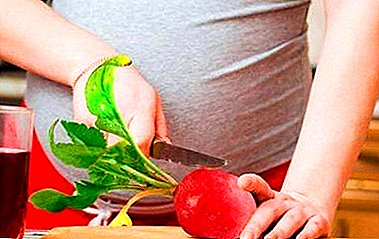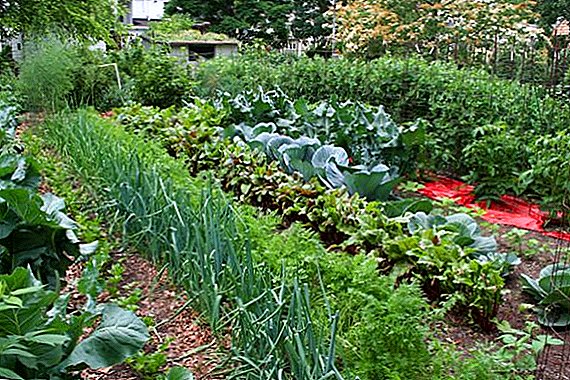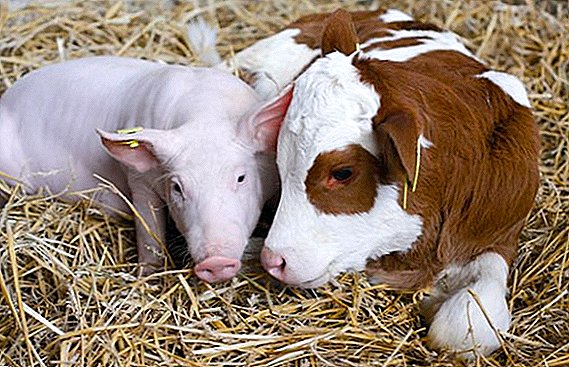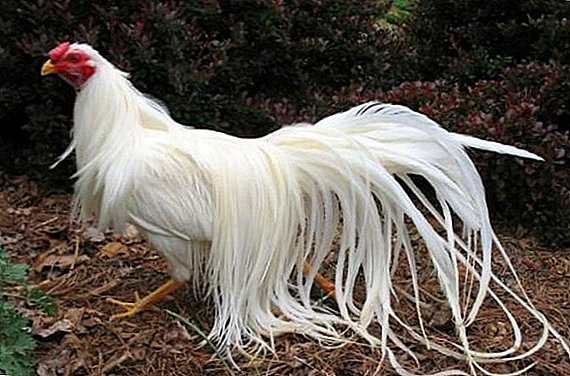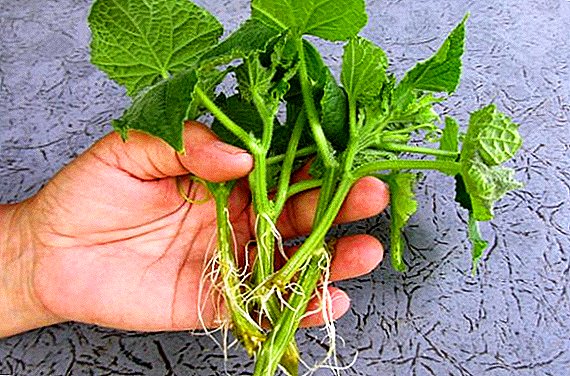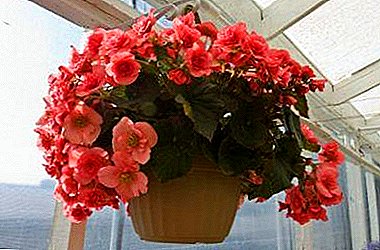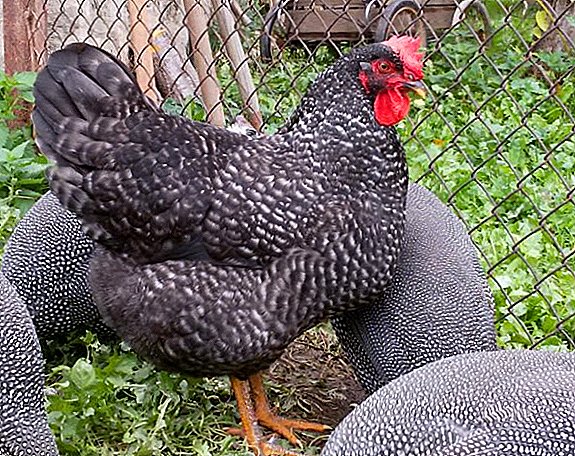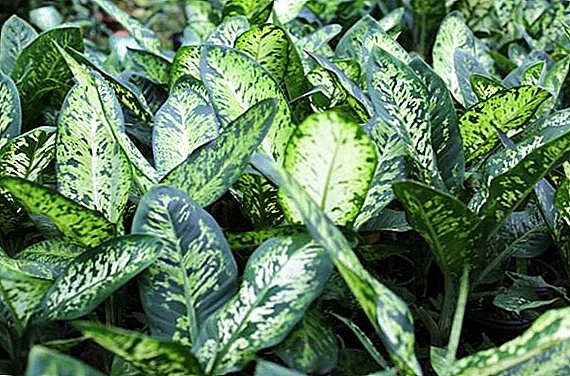 Diffenbachia Spotted lives in the homes of many gardeners and is pleasing to the eye with large leaves of original coloring. Subtleties of care and reproduction of this plant are described in detail below.
Diffenbachia Spotted lives in the homes of many gardeners and is pleasing to the eye with large leaves of original coloring. Subtleties of care and reproduction of this plant are described in detail below.
Botanical description of the plant
Tropical herb from South America belongs to the family of Aroids. As a houseplant common throughout the world. 
The characteristics of this type are:
- height up to 2 m;
- straight lignified stem;
- large leaves up to 50 cm long and 10-16 cm wide;
- leaf shape elongated, with pointed ends;
- leaf color is spotted, green and yellow;
- flowers - yellowish-white cobs, red fruits.
Did you know? The plant received its name from the surname of the senior gardener of the Botanical Garden in Vienna, Josef Dieffenbach, who lived in the 19th century.
Is it possible to keep in the house
Dieffenbachia can be grown at home, but the plant has a number of features that you need to know.
Signs and superstitions
About dieffenbachia known a lot of signs and superstitions.
The main ones are the following statements:
- This plant weakens the male energy and "kicks" men from home;
- leads to family quarrels and contributes to divorce;
- causes infertility.

Of the positive superstitions worth mentioning:
- bloom as an indicator of a negative situation;
- improving the appearance of the woman caring for the flower;
- improves career and business.
Benefit and harm
The beneficial properties of the plant include:
- purification of ambient air from harmful impurities;
- rapid growth and simplicity.
Important! Dieffenbachia is gradually turning towards the sun, therefore for uniform distribution of foliage it needs to be rotated evenly.
Necessary conditions and proper care
Dieffenbachia refers to unpretentious indoor plants, so that, following the proposed recommendations, we can guarantee its rapid growth, as well as easy reproduction.
Accommodation
Dieffenbachia tolerates half-shade, but in a lighted area the foliage will be brighter and more beautiful. It is not suitable for her full shadow and direct sunlight. Due to high growth, the plant is most often placed on the floor or a small stand. The location chosen should be located away from drafts, heaters and air conditioners. 
Air temperature and humidity
In summer, the temperature will be + 21 ... + 25 ° C, and in winter it may drop to + 18 ° C. It is advisable to avoid sharp fluctuations. For a short time, the plant can withstand cooler air, while the minimum allowable temperature value is + 13 ° C. Beautiful foliage will provide high humidity, not below 60-70%. The plant also likes spraying and showering, you can often wipe the leaves. Water for washing should not be hard to avoid the formation of plaque on the sheet plates.
Did you know? Slave owners often used "silent rods," forcing guilty slaves to chew on a sheet of dieffenbachia, which caused laryngeal edema and loss of speech.
Watering
The plant needs regular watering, especially in the summer. In winter, the frequency of hydration is reduced. Excessive soil moisture should be avoided. For irrigation should take soft, pre-settled water at room temperature. It is possible to use both sub-root watering and moistening through the pan. 
Top dressing
Starting in the spring, feeding should be done every two weeks. You can use standard complex mixtures or fertilizers for variegated plants. In autumn and winter, fertilizing can be completely stopped or carried out once a month in half the dose.
Pruning
In order to thicken the foliage and eliminate unnecessary exposure of the trunk, the tops are trimmed. The plant quickly releases new foliage from the buds near the cut. To preserve the decorative foliage, it is recommended to cut flowers and buds.
Important! The slice must be wet, removing the poisonous juice, and then sprinkle with coal powder for disinfection.
Transfer
For large specimens, it will be enough to replace the topsoil once every 2 years. Young seedlings are transplanted every year, and then transplantation is carried out every 3-4 years. The optimal time for work is early spring. The plant can grow both independently and in the overall composition. Hydroponics method is also used. The traditional soil mixture should be loose and nutritious, as well as with a neutral reaction (5.5 pH). 
On sale you can find a special primer for the Aroids or mix it in one of the following recipes:
- one part of peat, sand and sod land into four parts of leafy land;
- two parts of leafy soil, humus and peat on one part of the sand.
An important condition is a reliable drainage layer of at least 5 cm. The pot itself should not be too large to avoid rotting of the roots during watering.
The transplant is performed in the following sequence:
- The plant is removed from the old pot and inspect the roots.
- If the inspection of the roots did not reveal any problems, the existing soil is not removed. Diffenbachia is immediately placed in a new pot on a drainage, sprinkled with new soil, then a new ground is filled on the sides. The trunk of the plant is slightly buried, which should lead to the growth of new roots.
- If damage is found, the old soil must be removed, and then cut off unhealthy areas and sprinkle them with coal dust. The treated plant is planted in a new land.
Watering after transplantation can be carried out with the addition of a constrictor (for example, Kornevina).
Video: transplantation of spotted bang
How to propagate by yourself
Diffenbachia multiplies seeds and grafting. At home, use the second method, since obtaining seeds is extremely difficult. It is best for breeding cuttings cut tops. You can perform work at any time of the year.
The process happens like this:
- With a sharp knife you need to cut off the top with a few knots (15-18 cm). The cut should be covered with coal and dried for 24 hours.
- The cutting is placed in a mixture of equal parts of sand and peat, and then covered with film or glass.
- The planting is placed in a light (without direct rays of the sun) place at a temperature of + 25 ... + 27 ° C, ensuring regular ventilation.
- After the emergence of new shoots, the seedling is transplanted into an individual container.
You will be interested to know how to feed indoor flowers.
Rooting of the cutting in water is also possible. In this case, you need to wait for the formation of roots of 2-3 cm, and then plant a cutting in the ground. Propagating Dieffenbachia can be a segment of the stem at 15-20 cm (without leaves), but this method will take more time (up to 10 months).
For this you need:
- Cut the spots with coal.
- Lay the cuttings horizontally in the soil, half the thickness of the trunk.
- Cover the cutting with a film or glass and set it up like an apical cutting.
Video: Diefenbachia reproduction spotted cuttings
Possible difficulties in growing
According to the reviews of experienced flower growers, most of the problems in growing dieffenbachia arise from overwetting or excessive cooling:
- decay of the roots is shown by withering and blackening of the leaves and can cause complete destruction of the plant. It should immediately be transplanted to a new ground, while cutting off rotten roots. If the stalk softens at the base, the plant can no longer be saved and you can only cut off the top for rooting;
- hypothermia leads to falling foliage, like drafts or low humidity. Old leaves at the bottom die off naturally;
- waterlogging can lead to black spots - fungus, the fight against which is reduced to the processing of fungicides and stop spraying;
- drying out can be expressed in the brown edge of the sheet, and the direct rays of the sun can cause burns;
- The main plant pests are aphids, thrips, scab, and spider red mites. Their appearance is noticeable by the yellowing of a large number of leaves. To combat use insecticides.
 Dieffenbachia spotted enjoys well-deserved popularity, showing unpretentiousness and year-round decoration. Not forgetting the precautionary measures, its cultivation can be recommended for beginner gardeners.
Dieffenbachia spotted enjoys well-deserved popularity, showing unpretentiousness and year-round decoration. Not forgetting the precautionary measures, its cultivation can be recommended for beginner gardeners.

